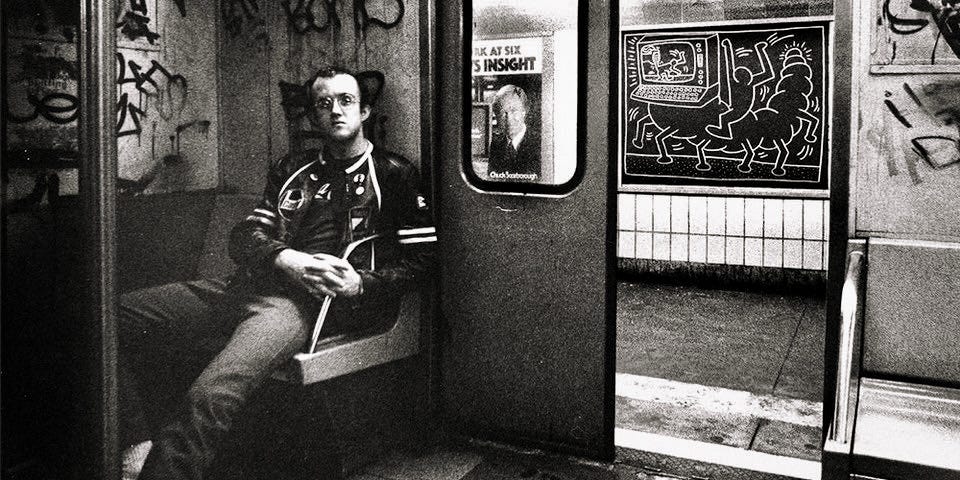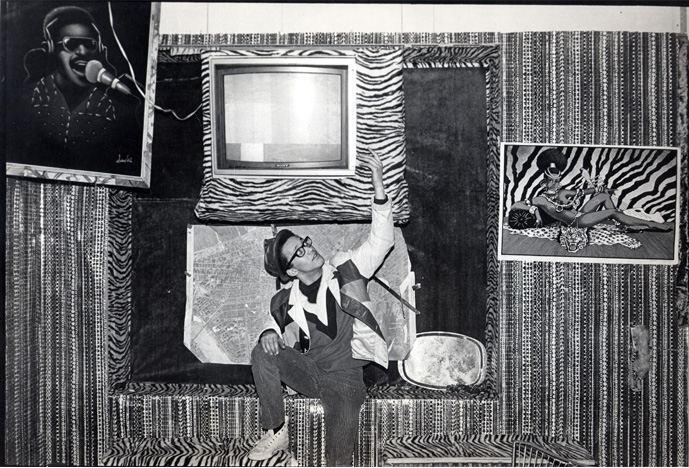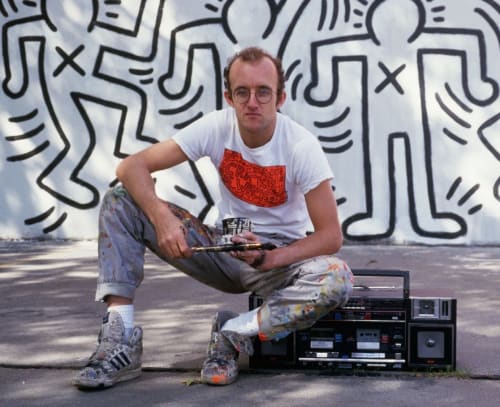Keith Haring’s iconic imagery—radiant babies, barking dogs, dancing figures, and energetic lines—feels as alive today as it did when it was made. While Haring is widely recognized for his bold, graphic aesthetic and activism, less commonly explored is the profound influence of music and dance on his artistic practice. For Haring, sound and movement were not peripheral inspirations—they were foundational. Music and dance didn’t just accompany his process; they animated his world, shaped his visual language, and infused his work with an unmistakable rhythm and energy.
The Rhythm of the City
In the late 1970s and early 1980s, New York City was a hotbed of cultural fusion. Hip-hop was rising from the Bronx, disco was peaking in nightclubs like Studio 54 and Paradise Garage, and punk rock throbbed through the East Village. Haring, who moved to New York in 1978 to attend the School of Visual Arts, was immediately drawn to this kaleidoscope of sound and movement. He immersed himself in downtown club culture and was a regular at venues that blurred the lines between nightlife, performance art, and activism.
One of the most formative spaces for Haring was Paradise Garage. More than just a nightclub, it was a haven for freedom of expression and queer liberation. DJ Larry Levan, known for his genre-defying sets, turned music into an emotional journey—something Haring deeply responded to. The physicality of dance, the collective joy, and the sense of belonging in that space found echoes in his art. In many ways, the dance floor was a sanctuary, and Haring translated its rhythm and spirit onto walls, canvases, and subway stations.

Drawing Like Dancing
Haring often compared his artistic process to dancing. His linework was fluid and instinctive, guided more by internal rhythm than by strict compositional planning. Watching Haring work—whether painting a mural or creating chalk drawings in the subway—was like watching a dancer in motion. He painted standing up, using his whole body in swift, confident gestures. His lines looped and bounced, always in motion, always alive. This sense of kinetic energy is central to understanding the dynamic quality of his work.
The spontaneity of breakdancing also influenced Haring's approach. As hip-hop culture exploded in the early '80s, Haring embraced its raw energy and innovation. He admired how breakdancers used public space for creative expression, reclaiming sidewalks and subway platforms for performance. In a similar vein, Haring’s subway drawings—done in chalk on vacant black advertising panels—transformed everyday spaces into temporary galleries. His practice became a kind of visual dance, choreographed on the spot for an unsuspecting audience.

Hip-Hop and Street Culture
Hip-hop music and culture deeply resonated with Haring’s values and style. Like graffiti artists, DJs, and MCs, Haring saw art as a democratic force—something that should be accessible, not confined to galleries. He was inspired by graffiti writers who tagged subway trains and buildings, creating a visual language outside of institutional constraints. Haring never considered himself a graffiti artist, but he respected its ethos and collaborated with many in the scene, including L.A. II (Angel Ortiz), whose intricate tag work often framed Haring’s paintings.
His collaborations with hip-hop musicians further demonstrate this crossover. He created stage visuals and backdrops for performers like Run-D.M.C. and took part in events that blended street art with music and dance. In 1984, he famously body-painted Grace Jones for a performance at the Paradise Garage, turning the singer’s body into a living canvas that danced under the lights. It was a moment that epitomized Haring’s belief that art, music, dance, and the body were interconnected.

Music as Message
Beyond style and energy, music also shaped the themes of Haring’s work. Many of his artworks explore freedom, unity, and the fight against oppression—messages echoed in the music of the time, especially in soul, disco, and socially conscious hip-hop. Songs that spoke to marginalized communities, racial justice, and queer identity found visual counterparts in Haring’s compositions.
He understood the power of rhythm to bring people together and used that same principle in his murals and public works. Pieces like Crack is Wack and Free South Africa harnessed bold, rhythmic lines to address urgent social issues, much like a protest song might. Haring saw his art as a form of visual activism, and music—especially its capacity to unify—was one of his greatest inspirations in this regard.

Club Culture and Queer Identity
For Haring, music and dance were more than aesthetic influences—they were part of his lived experience as a gay man in New York during the AIDS crisis. Clubs provided both creative and emotional refuge. They were spaces of visibility, community, and resistance. The dance floor became a place of joy amid hardship, where expression could be both personal and political.
Haring’s celebration of the human form—often dancing, writhing, or radiating energy—was also a celebration of queer life and love. These figures were not abstract ideas; they were reflections of real bodies in motion, liberated through dance and connected through sound. Even when his work grew darker in tone during the AIDS epidemic, the undercurrent of rhythm and defiance remained.
Visual Music
Keith Haring’s legacy is inseparable from the music and dance cultures that inspired him. His art, like a great song, bypasses intellectual analysis and hits you in the gut. It’s visceral, immediate, and unforgettable. Today, his works continue to resonate across disciplines—from murals and merchandise to music videos and stage designs.
Contemporary artists and musicians continue to draw from Haring’s synergy of sound and image. His belief that art should be for everyone echoes in today’s multidisciplinary, socially aware creative spaces. In murals on school walls, album covers, and club flyers, his dancing figures still move to the beat.
Keith Haring once said, “Art is for everybody.” That philosophy extended to his love of music and dance—art forms that are inherently communal, expressive, and accessible. In every line he drew, there’s a pulse; in every figure, a rhythm. Haring didn't just listen to music or watch people dance—he absorbed those experiences and let them guide his hand. His art dances, sings, and pulses with the life of the streets, the clubs, and the people who inspired him.
For collectors, scholars, and admirers alike, understanding the influence of music and dance on Haring is essential to appreciating the full vitality of his work. His legacy isn’t just in museums—it’s in the movement, the beat, and the shared joy of creative expression. Discover Keith Haring signed prints for sale and contact info@guyhepner.com for latest availabilities, Looking to sell? We can help. Find out how to sell Keith Haring prints with our New York and London teams.
